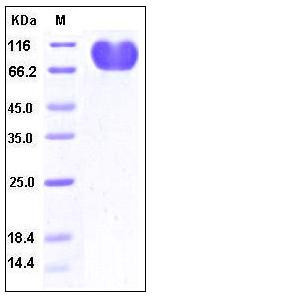Human CD155 / PVR / NECL5 Protein (Fc Tag)
CD155,HVED,Necl-5,NECL5,PVS,TAGE4
- 100ug (NPP1117) Please inquiry
| Catalog Number | P10109-H02H |
|---|---|
| Organism Species | Human |
| Host | Human Cells |
| Synonyms | CD155,HVED,Necl-5,NECL5,PVS,TAGE4 |
| Molecular Weight | The recombinant human CD155/Fc is a disulfide-linked homodimer. The reduced monomer consists of 561 amino acids and predicts a molecular mass of 61.8 kDa. As a result of glycosylation, the rhCD155/Fc monomer migrates as approximately 95-105 kDa band in SDS-PAGE under reducing conditions. |
| predicted N | Trp 21 |
| SDS-PAGE |  |
| Purity | > 97 % as determined by SDS-PAGE |
| Protein Construction | A DNA sequence encoding the extracellular domain (Met 1-Asn 343) of human CD155 (NP_006496.3) was expressed with the C-terminal fused Fc region of human IgG1. |
| Bio-activity | Measured by its binding ability in a functional ELISA . Immobilized human DNAM1 at 2 μg/ml (100 μl/well) can bind human CD155-Fc with a linear ranger of 0.032-0.8 μg/ml. |
| Research Area | Immunology |Innate Immunity |Monocytes/Macrophages |Monocyte Markers |
| Formulation | Lyophilized from sterile PBS, pH 7.4 1. Normally 5 % - 8 % trehalose and mannitol are added as protectants before lyophilization. Specific concentrations are included in the hardcopy of COA. |
| Background | CD155, commonly known as PVR (poliovirus receptor) and Necl-5 (nectin-like molecule-5), is a type I transmembrane single-span glycoprotein, and belongs to the nectins and nectin-like (Necl) subfamily. CD155 was originally identified based on its ability to mediate the cell attachment and entry of poliovirus (PV), an etiologic agent of the central nervous system disease poliomyelitis. The normal cellular function is in the establishment of intercellular adherens junctions between epithelial cells. CD155 may assist in an efficient humoral immune response generated within the intestinal immune system. It has been demonstrated that CD155 can be recognized and bond by DNAM-1 and CD96 which promote the adhension, migration and NK-cell killing, and thus efficiently prime cell-mediated tumor-specific immunity. |
| Reference |
